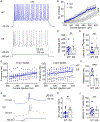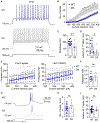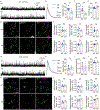NaV1.1 haploinsufficiency impairs glutamatergic and GABAergic neuron function in the thalamus
- PMID: 35219855
- PMCID: PMC8957548
- DOI: 10.1016/j.nbd.2022.105672
NaV1.1 haploinsufficiency impairs glutamatergic and GABAergic neuron function in the thalamus
Abstract
Thalamocortical network dysfunction contributes to seizures and sleep deficits in Dravet syndrome (DS), an infantile epileptic encephalopathy, but the underlying molecular and cellular mechanisms remain elusive. DS is primarily caused by mutations in the SCN1A gene encoding the voltage-gated sodium channel NaV1.1, which is highly expressed in GABAergic reticular thalamus (nRT) neurons as well as glutamatergic thalamocortical neurons. We hypothesized that NaV1.1 haploinsufficiency alters somatosensory corticothalamic circuit function through both intrinsic and synaptic mechanisms in nRT and thalamocortical neurons. Using Scn1a heterozygous mice of both sexes aged P25-P30, we discovered reduced excitability of nRT neurons and thalamocortical neurons in the ventral posterolateral (VPL) thalamus, while thalamocortical ventral posteromedial (VPM) neurons exhibited enhanced excitability. NaV1.1 haploinsufficiency enhanced GABAergic synaptic input and reduced glutamatergic input to VPL neurons, but not VPM neurons. In addition, glutamatergic input to nRT neurons was reduced in Scn1a heterozygous mice. These findings introduce alterations in glutamatergic synapse function and aberrant glutamatergic neuron excitability in the thalamus as disease mechanisms in DS, which has been widely considered a disease of GABAergic neurons. This work reveals additional complexity that expands current models of thalamic dysfunction in DS and identifies new components of corticothalamic circuitry as potential therapeutic targets.
Keywords: Dravet syndrome; Excitability; GABAergic; Glutamatergic; Na(V)1.1; Reticular thalamus; SCN1A; Somatosensory thalamus; Synaptic transmission; Thalamocortical neuron.
Copyright © 2022 The Authors. Published by Elsevier Inc. All rights reserved.
Conflict of interest statement
Declaration of interests
None
Figures








References
-
- Acker TM, Yuan H, Hansen KB, Vance KM, Ogden KK, Jensen HS, Burger PB, Mullasseril P, Snyder JP, Liotta DC, and Traynelis SF (2011). Mechanism for noncompetitive inhibition by novel GluN2C/D N-methyl-D-aspartate receptor subunit-selective modulators. Mol Pharmacol 80, 782–795. 10.1124/mol.111.073239. - DOI - PMC - PubMed
Publication types
MeSH terms
Substances
Grants and funding
LinkOut - more resources
Full Text Sources
Molecular Biology Databases

